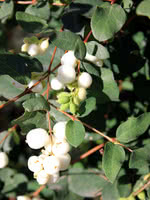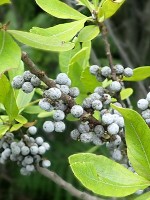Mon-Fri 9am - 5pm Mountain time
Common Snowberry vs Northern Bayberry
Symphoricarpos albus
Myrica pensylvanica
NOT AVAILABLE THIS SEASON - MIGHT RETURN
Common Snowberry is a small deciduous shrub with characteristic white to pink flowers and clusters of white fruit.
This North American native species is very adaptable, and can be used for erosion control in riparian and restoration areas. Snowberry's fruit attracts wildlife, and livestock can consume the berries without issue.
Northern Bayberry makes an excellent hedge or feature shrub. It will retain its leaves in warmer climates but drops them in colder areas. They produce blue-grey berries that have a wax coating on them that can be used to make candles or soaps.
In colder hardiness zones the leaves turn an attractive orange to red colour in the fall, making it a striking addition to your landscape.
Northern Bayberry is native to Nova Scotia and tolerates both drought and wet conditions. It is also a nitrogen fixer that tolerates poor soil conditions.
Common Snowberry Quick Facts
Northern Bayberry Quick Facts
Toxicity: berries toxic to humans
Toxicity: Warning: The wax from bayberry fruit is considered toxic and may be carcinogenic.

